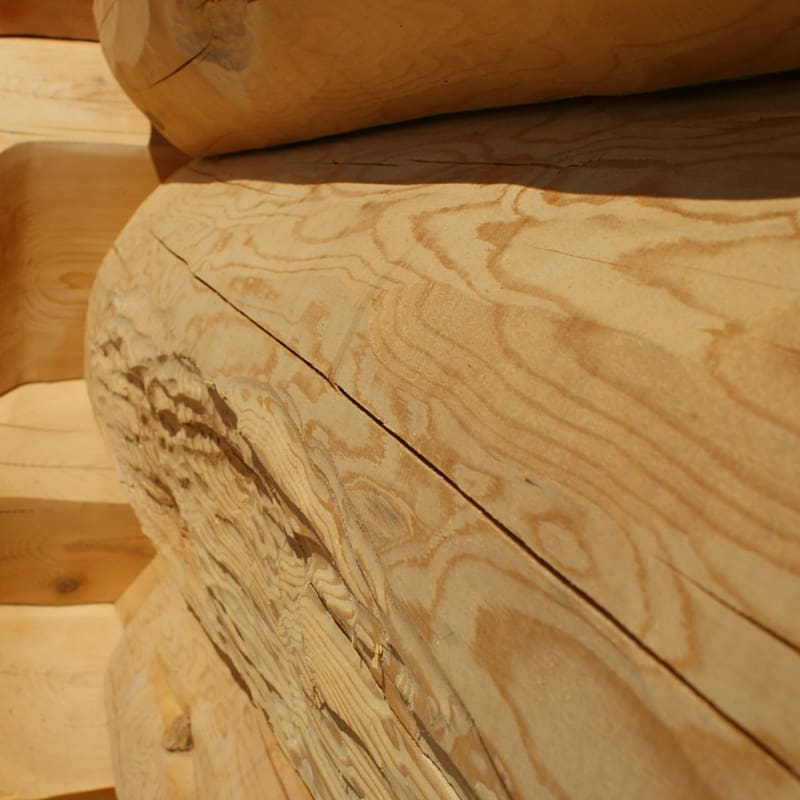This year we were faced with the opportunity of mounting a number of screw jacks (settling jacks) on top of all the vertical posts in a full scribe Cedar log home that is destined for California. Our clients had asked us to make them as low profile and least visible as possible. All the posts in this specific project have large flared (fluted) character ends that make it impractical to have screw jacks at the bottom which would allow them settle through the floor system into a space below.
Concealing the Screw Jacks
Two of the biggest challenges to mounting screw jacks are;
- keeping them accessible during theadjustment period, which can last up to 2 years and;
- keeping them concealed, in a non-obtrusive way,
while they’re not being adjusted.
The typical full scribe log home consisting of 9’ interior walls may settle anywhere from 2 to 6 inches
depending on species of wood and the moisture content of the wood. This means the space allowed for
settling plus the space needed for adjustment and the hardware, can be upwards of 10” to 12”. Keep in
mind, in most situations there must also be enough room around the traditional screw jack for a bottle
jack to be used to relieve the pressure during adjustment.
Location of Screw Jacks
Most traditional full scribe log homes built using non kiln dried wood will need some form of settlement adjustment for all vertical posts located within the full scribe level of the house. The screw jack can either be placed at or near the top of the post or at or under the bottom of the post.
If the jack is located on top of the post, a layer of wood trim or flashing will have to be built in order to conceal the lowering system, if a traditional jack is recessed into the top area of the post, a large panel of wood will have to be built to cover the access area. If the jack is located at the bottom of the post, the jack can be concealed in the floor joist system and accessed from below or a flashing or wood trim system will have to be built in place to conceal the settling area.
All these systems described above require an unsightly system of concealment that often looks out of place on a log post. Typical screw jack under post with and without flashing cover. Typical screw jack located at top of post.
Solution
When brainstorming ways to better conceal the screw jack system we came across the Joyce Dayton worm gear jack. We took this jack and combined it with 2 of our old techniques into one efficient, strong, easily adjustable and concealed system. This log project is currently under construction so we built a prototype.
Hardware needed
- Joyce Dayton worm gear screw jack. (We used a 3 tonne)
- 1/4” socket on a 12” extension
- 1/2” cordless drill
- layout tools and a chainsaw
Steps to concealing the jack inside top of post
This same system can be used at the bottom of a log post.
- Cut a 10”x8” block out of the top of the log post, 14” deep. (the jack will take up 6” of vertical space)
- Cut a 10” x 8” x 7” block to sit on top of the jack and carry the load of the log beam above. This block will be recessed 1” into your pocket during re-assembly and settle deeper as the jack is lowered during
adjustment. - If the bottom of your cut out is rough and uneven, we suggest using epoxy to level out the bearing area.
- Drill a 1”1/2 hole in the bottom of your pocket for the protection tube of the jack to fit into.
- Layout and drill a 1” access hole on the side of your post to access the input shaft (worm shaft) on the side of the jack. There are 2 input shafts on theses jacks, either can be used but keep in mind the up and down motion will be opposite.
- Cut a 1” dowel to plug the hole when not in use.
- Once your system is in place, the jack can be lowed (or raised) very easily by you, your contractor and
even the homeowner.


